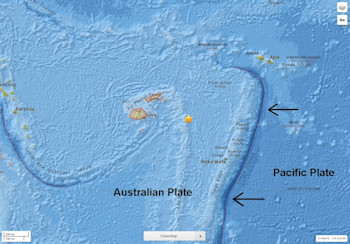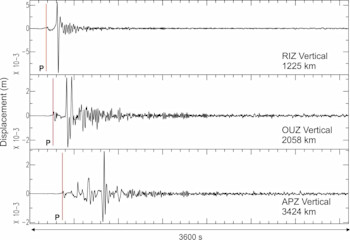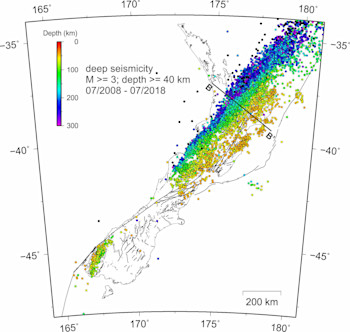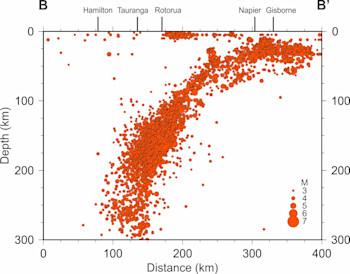
Yesterday’s M8.2 Fiji earthquake - a rare big, deep quake for the South Pacific
A very large and very deep earthquake near Fiji yesterday created several ghost quakes in our system, and quite a bit of interest on social media.
The magnitude 8.2 earthquake, which occurred at 12.19pm on Sunday 19 August (NZST), was 563km deep with an epicentre located between Fiji and Tonga. Because of its depth it was felt only lightly in Fiji and Tonga and there have been few reports of damage.
Deep earthquakes are relatively common in this location, where the Pacific Plate is being subducted under the Australian Plate; over the last century, nine earthquakes over M7 and more than 300km deep have been recorded within 250km of yesterday’s earthquake. However, this earthquake is one of the largest earthquakes to be recorded worldwide at this depth. The largest recorded very deep earthquake was a M8.3 quake that occurred at a depth of 600km beneath the Sea of Okhotsk near Russia in 2013, and a M8.2 earthquake also occurred at 650km depth near Bolivia in 1994.
Large earthquakes are rare at this depth, where it is so hot the rock has pretty much turned to mush. Earthquakes here are not simple ‘movement on a fault’ earthquakes that we see in the harder upper crust, but may involve other processes such as the mushy crust breaking apart, or transitions from one rock or mineral type to another because of the immense heat and pressure, which can cause rapid collapses in the rock.
One of the interesting things about these large, deep earthquakes is that while they cause less damage at the ground surface than shallow quakes, they can be felt a very long way from the source. We had 25 weak to light felt reports for this earthquake in New Zealand, mainly from the upper North Island, more than 2000km from the epicentre.
There have been 28 recorded aftershocks over M4.6 from this earthquake, which is also unusual. We don’t usually see many aftershocks from very deep earthquakes because the hot, soft rock around where the earthquake happened can adjust more slowly and easily to the nearby movement than colder, harder crust closer to the surface can.
What are ghost quakes again?
The Fiji earthquake generated many ghost quakes in our system, which is common for a large earthquake in the Pacific Islands.
Our seismic equipment is very sensitive and can detect seismic waves from earthquakes that happen a long way away. Ghost quakes happen when our automatic earthquake location system, which is set up to best locate New Zealand earthquakes, interprets the different waves arriving from a distant earthquake at different seismic sites as numerous closer and smaller earthquakes.
Because we are a long skinny country our system is tuned to assume that earthquakes to the north or south of New Zealand are close to New Zealand. In this case, when the earthquake waves arrived at our northernmost seismic stations our automatic system assumed the earthquake was close to New Zealand and assigned it an incorrect (lower) magnitude. When the earthquake waves arrived at seismic stations further south the automatic system didn't associate it with the 'first' earthquake because the arrival times appeared to be wrong for an earthquake close to New Zealand, so it assumed it was a separate earthquake. This happened several times across New Zealand as the earthquake waves travelled south - hence several ghost quakes. Fortunately this sort of occurrence is easily spotted and fixed by our duty seismologist - they will delete the ghosts and confirm the real quake.
Ghost quakes are a side effect of getting information out to you as quickly as possible, instead of waiting for up to 15 minutes for someone to check each earthquake before it goes up on our website or app. If we make our automatic system too picky on the quakes it reports, we might not get information about real earthquakes out rapidly. If we let the automatic system report on whatever information it picks up we sometimes get ghost quakes. We've gone for the speedy reporting option, and 99% of the time it works well.
Could this sort of earthquake create a tsunami?
These deep earthquakes are so deep that they themselves are very unlikely to create tsunamis, unlike similar-sized shallow earthquakes (less than about 50km deep). However, a deep earthquake could cause underwater landslides in susceptible sediments or rock so a localised tsunami is still possible.
Can large deep quakes like this occur in New Zealand?
Large deep earthquakes are unusual in New Zealand. We get deep earthquakes under the central and western North Island, as the Pacific Plate is pushed underneath the Australian Plate, but they are not usually deeper than about 400km (apart from some small earthquakes beneath Taranaki that can be more than 500km deep) and they are generally not large. We have never recorded an earthquake over M6.5 at that sort of depth. An M7+ earthquake at that depth is possible but unlikely, and a M8+ is very unlikely as these are very rare worldwide.
Does a large quake in the Pacific Islands increase the likelihood of a large earthquake in New Zealand?
No. Energy from big, deep earthquakes will travel around the entire earth a few times and sometimes, as this energy passes through New Zealand, it can trigger small earthquakes here (less than about M3). However, this ‘dynamic’ energy passes through New Zealand without permanently changing the stresses in the rocks here. In other words it doesn’t ‘load up’ our faults and make them more likely to move. We only see that sort of stress transfer, where a big earthquake can change the likelihood of an earthquake on another fault, within a couple of hundred kilometres of the earthquake.
Why does the earthquake not appear on the GeoNet website?
Our automatic system, which is set up to locate New Zealand earthquakes, initially interpreted the earthquake waves as a bunch of smaller earthquakes (ghost quakes) in or near New Zealand and automatically posted these to the GeoNet website. However, once our duty seismologist reviewed the earthquakes and revised them to one earthquake near Fiji, it was then outside the area that we can accurately locate earthquakes with our New Zealand-based seismic network. So, in effect it was no longer a ‘New Zealand’ earthquake and it was automatically removed from the GeoNet website.








